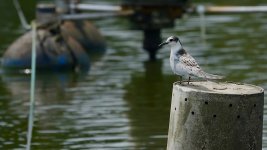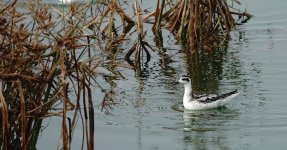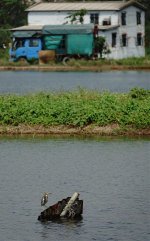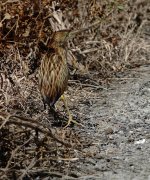MKinHK
Mike Kilburn

I've been in denial for a while about San Tin becoming my new patch. With the Magic Roundabout razed to make way for the Third Runway, and Pui O being filled in one soul destroying strip at a time, the San Tin fishponds have increasingly been my destination of choice over the last couple of years.
It's been a good site, both for me and for general birding in that time with a fine crop of extreme rarities including Hong Kong's first Small Pratincole, second Buff-breasted Sandpiper, third Booted Warbler and Water Pipit as well as other good birds such as Red-headed Bunting found by John Alcock on a Bird Race, and the three White-fronted Geese that commuted between here and Mai Po a couple of winters ago.
Today I wanted a site which I was sure would be accessible after last Sunday's mega typhoon, and so it turned out, although the lovely avenue of trees along the road from the minibus stop had taken a heavy pounding, and many were gone. The upside of this was I had a better view of the lotus pond on the western side of the road where a number of Chinese Pond Heron were fishing from the stems of the wind-blasted remnants of the lotuses.
Sadly there was significantly less activity here from the common woodland birds - Masked Laughingthrush, Eastern Great Tit, Japanese white-eye etc, which seem to have been hit hard all across Hong Kong, but I did here the jeers of a couple of Azure-winged Magpies, and both Spotted Dove and both Chinese and Crested Bulbuls were still active, and a Common Kingfisher called from cover on the Lotus Pond.
Once entering the fishpond proper I was pleased to find a White-winged Tern patrolling the first pond and a Dabchick with a near full-grown youngster in close attendance, plus the usual suite of Great and Little Egrets along with a few Black-crowned Night Herons and the odd White-breasted Waterhen. This part of the site is good for starlings and mynas - Common Myna has its Hong Kong stronghold here, and it was good to see plenty of Black-necked Starlings and Crested Mynas plus three or four White-shouldered Starlings, a rather early Silky Starling and a couple of probable Daurian Starlings over the course of the morning. They along with a host of Collared, Spotted and Red Turtle Doves compete with the Tree Sparrows for the piles of stale bread heaped onto the side of the fishponds before they are fed to the fish.
A drained pond that had performed well in August - a Temminck's Stint on 18th was a new early autumn date for HK by four days - today held Green, Wood, and Common Sandpipers, plus an Avocet, Long-toed, Temminck's and Red-necked Stints, ten or so LRPs, a couple of Common Snipe and the first of many Black-winged Stilts. I also flushed a juvenile Yellow Bittern nearby.
Turning eastwards I crossed the dangerously rickety bridge over one of the drainage channels, seeing a couple of Black Drongos and a Black-winged Cuckooshrike on the wires and a couple of Yellow Wagtails on the pond bunds. What I initially thought was a low-flying accipiter turned out to be an Oriental-type Cuckoo. These birds are very frustrating as they could by Oriental, Himalayan, and even possibly Common Cuckoo, but unless they call are just about impossible to separate - especially on distant fly-by views.
I was delighted to find some 30 Red-necked Phalaropes spread across the ponds on the eastern edge of the site. It's several years since I've seen these delightful birds up-close, but these birds were typically confiding as they puttered along the edge of the ponds chirruping occasionally to each other.
Leaving the best to last, the marquee bird of the day was a Lesser Treeduck that I had seen very briefly flying away earlier on. It had pitched into a pond near my exit route so I was delighted to connect just before leaving the site to head home. It gave me a moment of stress as it was not initially in view, while the long-staying Common Pochard lazing comfortably on the next pond had me wondering if I had been stringing the tree duck when I identified it in flight. Just as I was about to put out a "false alarm" message for my earlier (tree duck is less than annual in HK) sighting, it drifted into view behind a phalarope - saving me from looking like a plonker! The Treeduck has been seen a few times at Mai Po and the nearby Lok Ma Chau wetland over the summer, but had not been reported since early August, so it was a nice "self-find" - at least according to my self found rules! - bringing my HK total to 406.
Cheers
Mike
It's been a good site, both for me and for general birding in that time with a fine crop of extreme rarities including Hong Kong's first Small Pratincole, second Buff-breasted Sandpiper, third Booted Warbler and Water Pipit as well as other good birds such as Red-headed Bunting found by John Alcock on a Bird Race, and the three White-fronted Geese that commuted between here and Mai Po a couple of winters ago.
Today I wanted a site which I was sure would be accessible after last Sunday's mega typhoon, and so it turned out, although the lovely avenue of trees along the road from the minibus stop had taken a heavy pounding, and many were gone. The upside of this was I had a better view of the lotus pond on the western side of the road where a number of Chinese Pond Heron were fishing from the stems of the wind-blasted remnants of the lotuses.
Sadly there was significantly less activity here from the common woodland birds - Masked Laughingthrush, Eastern Great Tit, Japanese white-eye etc, which seem to have been hit hard all across Hong Kong, but I did here the jeers of a couple of Azure-winged Magpies, and both Spotted Dove and both Chinese and Crested Bulbuls were still active, and a Common Kingfisher called from cover on the Lotus Pond.
Once entering the fishpond proper I was pleased to find a White-winged Tern patrolling the first pond and a Dabchick with a near full-grown youngster in close attendance, plus the usual suite of Great and Little Egrets along with a few Black-crowned Night Herons and the odd White-breasted Waterhen. This part of the site is good for starlings and mynas - Common Myna has its Hong Kong stronghold here, and it was good to see plenty of Black-necked Starlings and Crested Mynas plus three or four White-shouldered Starlings, a rather early Silky Starling and a couple of probable Daurian Starlings over the course of the morning. They along with a host of Collared, Spotted and Red Turtle Doves compete with the Tree Sparrows for the piles of stale bread heaped onto the side of the fishponds before they are fed to the fish.
A drained pond that had performed well in August - a Temminck's Stint on 18th was a new early autumn date for HK by four days - today held Green, Wood, and Common Sandpipers, plus an Avocet, Long-toed, Temminck's and Red-necked Stints, ten or so LRPs, a couple of Common Snipe and the first of many Black-winged Stilts. I also flushed a juvenile Yellow Bittern nearby.
Turning eastwards I crossed the dangerously rickety bridge over one of the drainage channels, seeing a couple of Black Drongos and a Black-winged Cuckooshrike on the wires and a couple of Yellow Wagtails on the pond bunds. What I initially thought was a low-flying accipiter turned out to be an Oriental-type Cuckoo. These birds are very frustrating as they could by Oriental, Himalayan, and even possibly Common Cuckoo, but unless they call are just about impossible to separate - especially on distant fly-by views.
I was delighted to find some 30 Red-necked Phalaropes spread across the ponds on the eastern edge of the site. It's several years since I've seen these delightful birds up-close, but these birds were typically confiding as they puttered along the edge of the ponds chirruping occasionally to each other.
Leaving the best to last, the marquee bird of the day was a Lesser Treeduck that I had seen very briefly flying away earlier on. It had pitched into a pond near my exit route so I was delighted to connect just before leaving the site to head home. It gave me a moment of stress as it was not initially in view, while the long-staying Common Pochard lazing comfortably on the next pond had me wondering if I had been stringing the tree duck when I identified it in flight. Just as I was about to put out a "false alarm" message for my earlier (tree duck is less than annual in HK) sighting, it drifted into view behind a phalarope - saving me from looking like a plonker! The Treeduck has been seen a few times at Mai Po and the nearby Lok Ma Chau wetland over the summer, but had not been reported since early August, so it was a nice "self-find" - at least according to my self found rules! - bringing my HK total to 406.
Cheers
Mike
Attachments
Last edited:






























